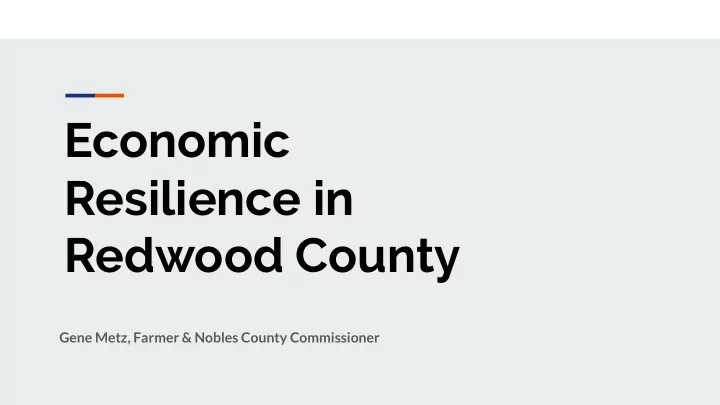

Economic Resilience in Redwood County Gene Metz, Farmer & Nobles County Commissioner
Background 1973 SDSU graduate with an Agriculture Economics degree ● Began farming in 1973, currently specializes in corn, soybeans, ● and hog production. Lifelong resident of Nobles County and in 7th year as Nobles ● County Commissioner
Redwood County Energy Dialogue Today’s Presentation Economic Security on the Ridge? Economic Benefits & Drawbacks for Communities, Agriculture, and Counties Minnesota’s Wind Farms Ways to Maximize Benefits & Minimize Drawbacks for Communities, Agriculture, and Counties Condition of Local & Agricultural Economies Wind Development & Property Values Impact by the Numbers Wind Development & Property Sales
Economic Security on the Ridge? Primary industries in Nobles County Row crop & animal ag ● Meatpacking & related ● Animal bio-health vaccine production ● Mobile home manufacturing ● Future industries All of the above ● Renewable energy support ● Land use purposes Continued emphasis on agriculture ● Renewable energy sites (wind, solar, biofuels) ● Farmland → recreational uses ●
Minnesota’s Wind Farms High concentration of wind farms along ● Buffalo Ridge in SW Minnesota Unique topography enhances the sustained ● wind speeds Borders South Dakota & Iowa, often more ● business-friendly because of tax law and business permitting and rules
Condition of Agricultural Economy Grain & livestock industries spending time Aging ownership base 1 4 below break-even cost of production Consolidation of farms Impact of health care costs 2 5 Dependent on migrant workforce Increasing dependency on off-farm income 3 6
Impacts of Wind Development on Rural Economies
Wind development is a source of revenue for counties that doesn’t come from Impact by the the pocketbooks of citizens, allowing counties to reinvest as they see fit. Numbers* 30% of Minnesota’s counties receive this revenue. More than More than $7.4B $10M $12M Capital investments in Annual lease payments to Annual Production Tax revenue Minnesota from wind energy landowners in Minnesota received by 26 Minnesota counties *Compiled by the Clean Grid Alliance
Economic Benefits for Communities “Main Street” dollars during construction Potential for lower electric rates 1 3 High salary jobs during operation Community fund 2 4
Agricultural Benefits Value added dollars to existing property 1 Guaranteed yearly income 2 without any investment Ability to use service roads for farming 3 operations Potential for increased yields 4 Farmland preservation and reinvestment 5
Agricultural Benefits Question: Since 2008, about how much money have you spent on…* Average of all Average of those with responses turbines on their property ...improvements to your home? $26,897 $41,970 ...improvements to your outbuildings? $36,251 $71,780 ...improvements to your field drainage and irrigation? $25,321 $57,863 ...purchasing new or used farm equipment? $125,027 $279,539 * Field work conducted and data gathered by the University of Michigan’s Ford Policy School
Economic Benefits for Counties Steady source of income from “Production Typical County uses for Production Tax dollars: 1 3 Tax” without the need for capital Levy buydown ● investment Road improvements ● Building projects ● Broadband ● Tax forfeited property cleanup ● Project in operation doesn’t ask for: 2 Tax abatements ● Water source ● Electric ● Waste disposal ●
Economic Drawbacks for Communities Sourcing capable workforce during Running out of transmission capacity 1 3 construction and operational jobs Wind doesn’t blow all the time Disposal of “spent” wind turbine parts 2 4
Ways to Maximize Benefits for Communities “Main Street” dollars during construction Potential for lower electric rates 1 3 - Short-term: Build awareness of local - Develop methods to bring power produced businesses, services and attractions with here onto our local grid temporary workers High salary jobs during operation Community fund 2 4 - Long-term: Make the community a good - Energize the communities to find suitable projects and place to live and work for the next 20+ spend wisely years (schools, medical services, entertainment/culture)
Ways to Minimize Drawbacks for Communities Sourcing capable workforce during Running out of transmission capacity 1 3 construction and operational jobs - Begin studies of next level of transmission systems - Invest in local community & technical - Develop methods to tap into existing grid for our own local use colleges to “grow our own” Wind doesn’t blow all the time Disposal of “spent” wind turbine parts 2 4 - Continue development of companion - Find ways to reuse usable smaller machines as projects are repowered “green” energy sources as well as storage - Find environmentally friendly ways to dispose of non-usable parts
Wind Development and Land Leases A wind farm lease is an agreement between a developer and a property owner that grants the developer the necessary rights to develop turbines at an agreed upon location. In return, the property will receive monthly rental payments from the developer for a set period of time.
Wind Development and Property Values Impact on property values? No evidence of an effect on home prices in proximity to wind turbines* * According to a 2013 study by the Lawrence Berkeley National Laboratory using data of more than 50,000 homes in 27 counties, located in 9 different states and affirmed by similar studies from the University of Rhode Island and University of Connecticut
Wind Development and Property Sales Location from Sales % site All Qualified Sales from 1/1/2015-12/31/2016* # of turbines within 1 mile Sales % None 91.52% Median 88.61% 0 turbines 91.52% North 110.97% 1-10 turbines within 1 mile 110.06% South 88.61% Distance from wind turbine Sales % East N/A 11-18 turbines within 1 mile 88.61% Turbine ¾ to 1 mile from site 88.61% West 88.61% No turbine within 1 mile 91.52% Turbine ½ to ¾ mile from site 88.61% Northwest 88.61% Turbine up to ½ mile from site 88.61% Northeast 81.87% * Data provided by the Jackson County Assessor No turbine within 1 mile 91.52% Southwest 88.61% Southeast 88.61%
Thank you! Questions?
Recommend
More recommend